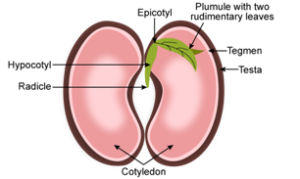Selina Concise Biology Class 9 ICSE Solutions Seeds: Structure and Germination
APlusTopper.com provides step by step solutions for Selina Concise ICSE Solutions for Class 9 Biology Chapter 6 Seeds: Structure and Germination. You can download the Selina Concise Biology ICSE Solutions for Class 9 with Free PDF download option. Selina Publishers Concise Biology for Class 9 ICSE Solutions all questions are solved and explained by expert teachers as per ICSE board guidelines.
Download Formulae Handbook For ICSE Class 9 and 10
ICSE SolutionsSelina ICSE Solutions
Selina ICSE Solutions for Class 9 Biology Chapter 6 Seeds: Structure and Germination
Exercise 1
Solution A.
- (c) Maize grain ______ coleoptile
- (d) do not get enough oxygen
Solution B.1.
(a) F (False). Monocotyledonous seeds contain one cotyledon and dicotyledonous seeds contain two cotyledons.
(b) T (True)
(c) T (True)
(d) T (True)
Solution B.2.
(a) Maize
(b) Pyrogallic acid
(c) Shoot
(d) Rhizophora
(e) Aleurone layer
(f) Bean
Solution B.3.
(a) plumule, above
(b) Coleorhiza, coleoptile
(c) seed coat, testa
(d) micropyle
(e) starch
Solution B.4.
(a) Micropyle, 1st male gamete, egg cell, zygote, embryo
(b) Allogamy, fusion of gametes, zygote, embryo, seed
(c) Seed coat bursts, radicle grows downward, hypocotyls form loop above the soil, epicotyls elongate
Solution C.1.
A seed is a mature ovule after fertilization. It contains a tiny living-plant called the embryo. The embryo within the seed remains in an inactive or dormant state, until it is exposed to favourable conditions, when it germinates.
Solution C.2.
Endospermic (albuminous) seeds: E.g. Castor, Maize, Poppy
Non-endospermic (exalbuminous) seeds: E.g. Bean, Gram, Pea
Solution C.3.
Germinated grams are considered highly nutritive because the cotyledon of the seed absorbs food from the endosperm, making it nutritive. It is rich in starch and its outermost layer is rich in protein.
Solution C.4.
Maize grain is actually a fruit in which the fruit wall and the seed coat are fused together to form a protective layer. Therefore, we do not use the terms maize fruit and maize seed. Instead, we call such fruits as grains.
Solution D.1.
(a) Seed coat: It protects the delicate inner parts of the seed from injury and the attack of bacteria, fungi and insects.
(b) Micropyle: During germination, micropyle allows water to enter the seed through its pore.
(c) Cotyledons: They contain food for the embryo.
(d) Radicle: It forms the future root.
(e) Plumule: It forms the future shoot.
Solution D.2.
Aim: To prove that a suitable temperature is necessary for germination.
Apparatus: Two beakers, wet cotton wool, refrigerator
Procedure:
- Take two beakers and label them as A and B.
- Place some gram seeds on wet cotton wool in each of the beakers.
- Keep beaker A at ordinary room temperature and beaker B in the refrigerator.
- In 1-2 days, the seeds in beaker A will germinate, showing the importance of a suitable temperature for germination. Seeds in beaker B may not show the signs of germination or may germinate after several days, though not to the extent as the seeds in beaker A.
Inference: Seeds require a suitable temperature for germination.
Solution D.3.
Yes, we call it germination because all the changes leading to the formation of a seedling collectively constitute germination. During germination, either the epicotyl or the hypocotyl elongates.
Solution D.4.
(a) Epigeal germination and Hypogeal germination
| Epigeal germination | Hypogeal germination |
| 1. Cotyledons are pushed above the ground | 1. Cotyledons remain underground |
| 2. Hypocotyl elongates | 2. Epicotyl elongates |
(b) Coleorhiza and Coleoptile
| Coleorhiza | Coleoptile |
| 1. Protective sheath of radicle | 1. Protective sheath of plumule |
| 2. Present towards the pointed end of embryonic region | 2. Present towards the upper broader side of the embryonic region |
(c) Bean seed and Maize grain
| Bean seed | Maize grain |
| 1. Two cotyledons | 1. One cotyledon |
| 2. No endosperm | 2. Large endosperm present |
Solution D.5.
| Germination | Vivipary |
| When the embryo in the seed becomes activated and begins to grow into a new plant, then it is known as germination. | Vivipary is known as the germination of seed within the fruit, while it is still attached to the parent plant. |
Solution D.6.
A fruit is the enlarged ripened ovary in which the ovarian wall forms the fruit wall and encloses the seed. The fruit protects the seed and helps in seed dispersal.
The maize grain is regarded as a ‘one-seeded fruit’ because the fruit wall and the seed coat are fused to form a protective layer. Such a fruit is called grain.
Solution D.7.
Germination of a seed which takes place above the ground is called epigeal germination. In epigeal germination, the hypocotyl grows forming a loop above the soil. It then straightens pushing the cotyledons above the ground.
Solution D.8.
(a) The ‘micropyle’ serves two important functions:
- Allows absorption of water and makes it available to the embryo for germination.
- Enables diffusion of respiratory gases for the growing embryo
(b) The embryo of the seed grows into the seedling.
(c) Structure of embryo

(d) The cotyledons of the seed provide nutrition for the growing seedling or the embryo.
More Resources for Selina Concise Class 9 ICSE Solutions